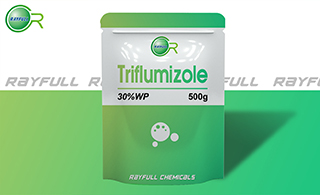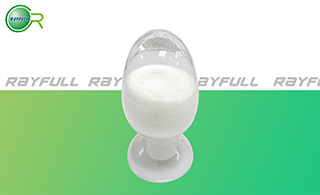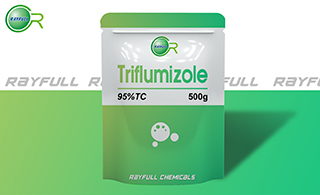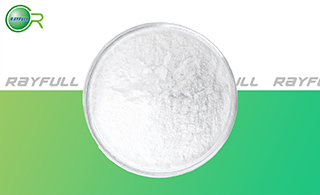Triflumizole
    ·ъҫъЯт ·ъҫъЯт
Introduction: Triflumizole is a conazole fungicide used to control powdery mildew, scab and other diseases on top fruit, grapes and other crops. Its mode of action is systemic with protective and curative action. It is an inhibitor of chitin biosynthesis.
Common name: Triflumizole
Another name: Triflumizol; Terraguard; Procure; Trifmine; Trifumine; Condor; etc.
Chemical name: (E)-4-chloro-ҰБ,ҰБ,ҰБ-trifluoro-N-(1-imidazol-1-yl-2-propoxyethylidene)-o-toluidine
Empirical formula: C15H15ClF3N3O
Structural formula:

Mol. Weight: 345.75 g/mol
CAS No.: 68694-11-1
Specifications
Leading Triflumizole supplier
Triflumizole 95% TC
Triflumizole 30% WP
Packing:
BULK PACKING
Powder: 25kg/Bag, 25kg/Drum, 50kg/Drum etc.
Liquid: 200L/Drum, 20L/Drum, 10L/Drum etc.
SMALL PACKING
Powder: 1kg/Alu bag, 500g/Alu bag, 200g/Alu bag, 100g/Alu bag, 50g/Alu bag, 15g/Alu bag etc.
Liquid: 5L/Drum, 1L/Bottle, 500ml/Bottle, 250ml/Bottle, 100ml/Bottle, 50ml/Bottle etc.
Customerized packing label
Triflumizole FAO standard
Professional registration
HAZARDS IDENTIFICATION
Hazard statement(s)
H302 (100%): Harmful if swallowed.
H317 (13.33%): May cause an allergic skin reaction.
H400 (13.33%): Very toxic to aquatic life.
H410 (13.33%): Very toxic to aquatic life with long lasting effects.
H411 (76.67%): Toxic to aquatic life with long lasting effects.
Precautionary statement(s)
P261: Do not breathe dust/fume/gas/mist/vapors/spray.
P264: Wash ... thoroughly after handling.
P270: Do not eat, drink or smoke when using this product.
P272: Contaminated work clothing should not be allowed out of the workplace.
P273: Avoid release to the environment.
P280: Wear protective gloves/protective clothing/eye protection/face protection.
P301+P312: IF SWALLOWED: call a POISON CENTER/doctor/... IF you feel unwell.
P302+P352: IF ON SKIN: wash with plenty of water.
P321: Specific treatment (see ... on this label).
P330: Rinse mouth.
P333+P313: IF SKIN irritation or rash occurs: Get medical advice/attention.
P363: Wash contaminated clothing before reuse.
P391: Collect spillage.
P501: Dispose of contents/container to an approved waste disposal plant.
Supplemental Hazard Statements: none.
MAMMALIAN TOXICOLOGY
Acute toxicity: 1) Acute oral LD50 for rats is 1057 mg/kg. 2) Acute dermal LD50 for rats is >5000 mg/kg. 3) Acute inhalation toxicity LC50 (4 h) for rats is >3.6 mg/L. 4) Skin irritation: Non-irritating to skin (rabbits). 5) Eye irritation: Slightly irritating to eyes (rabbits). 6) Skin sensitization for guinea pig: Sensitizer (maximization test).
NOEL: (2 y) for rats is 3.5 mg/kg/day; (2 y) for mice is 16 mg/kg/day; (1 y) for dogs is 10 mg/kg/day. Other No carcinogenic potential. Negative in Ames, REC assay, chromosomal aberration and mouse micronucleus tests.
ADI (JMPR) 0-0.04 mg/kg b.w. [2013]
Classification:
WHO Classification: II (Moderately hazardous)
EC Risk Classification: Xn - Harmful: R22, R43; N - Dangerous for the environment: R50, R53
US EPA Classification (formulation): III (Caution - Slightly toxic)
ECOTOXICOLOGY
Effect on birds: Acute oral LD50 for Bobwhite quail is >2510 mg/kg. Effect on fish: Acute LC50 (96 h) for Rainbow trout is 0.57 mg/l. Effects on aquatic invertebrates: Acute EC50 (48 h) for Daphnia magna is 2.11 mg/l. Effects on algae: Acute 72 hour EC50 for Scenedemus subspicatus is 1.66 mg/l. Effects on bees: contact acute 48 hour LD50 is 20 ҰМg/bee, oral acute 48 hour LD50 is 14 ҰМg/bee.
ENVIRONMENTAL FATE
Animals For details of metabolism in rats, see T. Tanoue et al., IUPAC 7th Int. Congr. Pestic. Chem., 1990, 2, 177. Soil/Environment In soil, DT50 14 d (on clay). Photolytic degradation leads to the metabolite (E)-4-chloro-a,a,a-trifluoro-N-(1-amino -1-yl-2-propoxyethylidene)-o-toluidine. Koc 1083-1663.
Usage: Triflumizole was introduced by Nippon Soda Co., Ltd. It is a fungicide used to control fungal diseases on top fruit, grapes and other crops.
Application: Biochemistry Steroid demethylation (ergosterol biosynthesis) inhibitor. Mode of action Systemic fungicide with protective and curative action. Uses Control of Gymnosporangium and Venturia spp. in pome fruit, against powdery Erysiphaceae in fruit and vegetables, and against Fusarium, Fulvia and Monilinia spp. Application at 180-300 g/ha in vegetables, and 700-1000 g/ha in orchards. It is also used as a seed treatment against Bipolaris oryzae, Tilletia and Ustilago spp. in cereals.
| 






